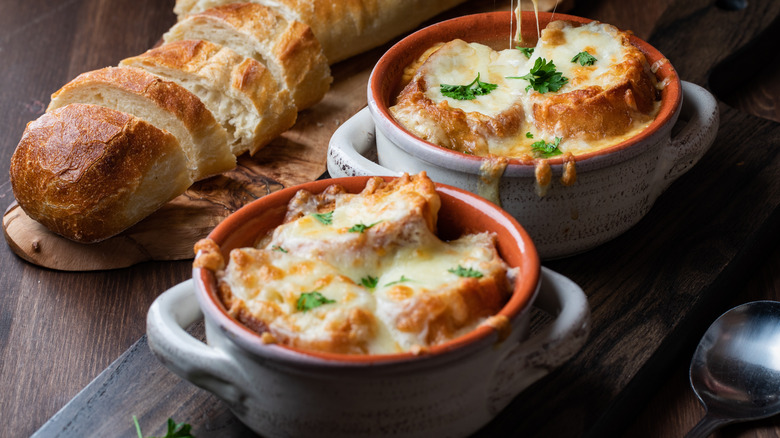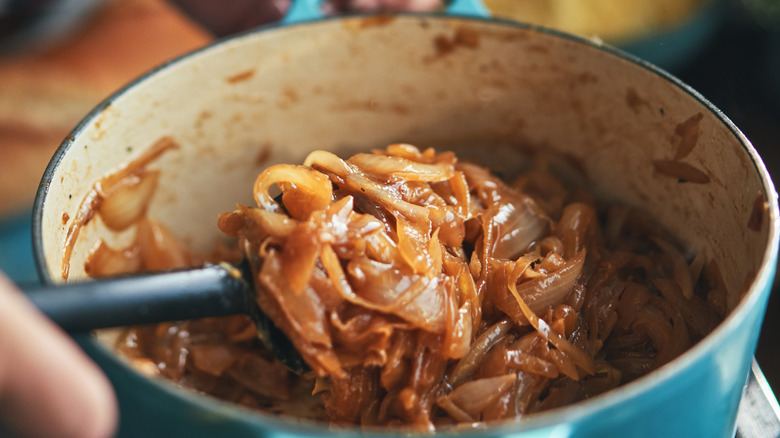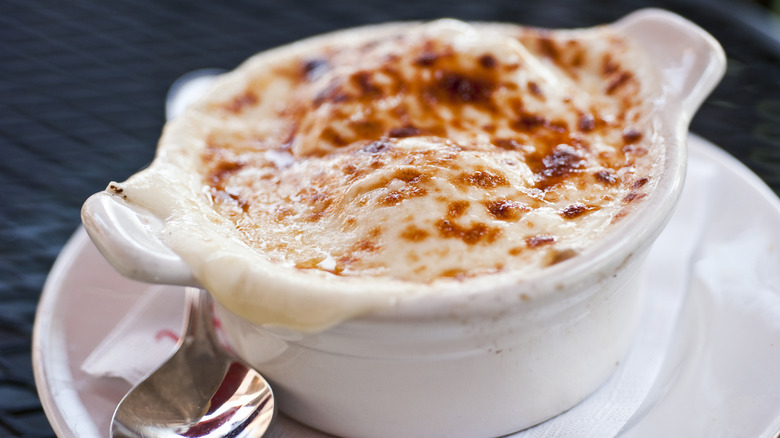The Onions You Need For The Best Bowl Of French Onion Soup
French onion soup, or soupe à l'oignon gratinée as the French call it, is a staple on pub, diner, and upscale restaurant menus, but it's easy to make at home, too. When prepared properly, this simple recipe is the epitome of comfort, offering spoonfuls of sweet, umami-packed broth draped with melted cheese like a warm blanket.
Recipes vary in terms of which onion type is used: sweet, red, yellow, or white being the most common, while most avoid tiny shallots, Cipollini, and pearl onions. While there are merits to using each kind, truly all you need are basic yellow onions for the best bowl of French onion soup; even Jacques Pépin and Julia Child agree, as seen in this clip from "Julia & Jacques Cooking at Home."
Luckily, since most of the onions grown in the U.S. are yellow, they are the least expensive option. They have a high starch content, which allows them to caramelize quickly, bringing out the root's sugars without breaking down into mush. Spanish onions are a more mellow type of yellow and can be used interchangeably.
French onion soup made with sweet onions is delicious too, but just be prepared to spend more time sauteing if you go this route. Sweet varieties like Vidalia, Maui, and Walla Walla have the highest sugar content but also more water, which means it'll take longer to break them down and caramelize. These squatty varieties are also seasonal, making them more expensive. Red and white onions are less sweet and best enjoyed raw (red onions are prized for their color and turn a less appealing grey color when caramelized).
Tips for making French onion soup
With just four ingredients — onions, stock, bread, and cheese — the key to French onion soup is patience. Some cooks like to add a pinch of sugar to help the alliums caramelize, or they'll attempt to change the pH by adding in baking soda, but neither step is necessary if you use the ideal pick, yellow onions.
Yellow onions should be slow-cooked until golden brown, which will soften their texture and coax their natural sugars. This process requires more onions and time than expected to deliver a rich flavor and deep, golden brown color, however (three pounds of sliced onions are reduced to just four soup servings).
Resist the urge to turn up the heat when cooking, too. Rushing the process will darken the onions' color but won't give them enough time to sweeten. Plus, once most of the water content has evaporated, it's easy to burn the onions over this high heat, resulting in an acrid taste. So take it slow and steady, planning at least an hour to caramelize everything.
As well, you'll want to cook the onions in a heavy bottom pot over a low flame to prevent them from burning. Avoid using a non-stick surface, which hampers fond from forming, as you'll want that layer to add depth to the soup. For the best caramelization, sautè the onions in butter or use a combination of butter and oil; duck fat and butter would be a delicious combination, too.
Ways to play with French onion soup recipes
Using alcohol is another easy way to enhance the flavor and add another dimension to this soup. Not surprisingly, Julia Child and Jaques Pépin gave their French onion soup a generous amount of red wine. The late Anthony Bourdain also enhanced the soup's sweetness by including balsamic vinegar and port wine in his recipe. If you're not a wine drinker, Guinness beer is used for an Irish version of French onion soup, which also replaces traditional croutons with Irish soda bread.
Beef stock is traditionally used but it's not a rule. Bourdain preferred homemade chicken stock, and Alton Brown adds richness to his onion soup by replacing the stock with beef consommé. Vegetarian versions rely on the meatiness of mushrooms to deliver an intensely flavored soup without including meat.
Some upscale versions of the soup forgo the melted cheese topping for puff pastry instead. Although encasing the crock with it is undoubtedly buttery and delicious, French onion soup isn't the same without melted cheese on top, so maybe keep the puff pastry for fancy chicken pot pies. When it comes to the cheese, stick with Gruyere or Emmental — both of these Swiss cheeses melt easily, creating a string of nutty-tasting deliciousness from the crock to your mouth.



